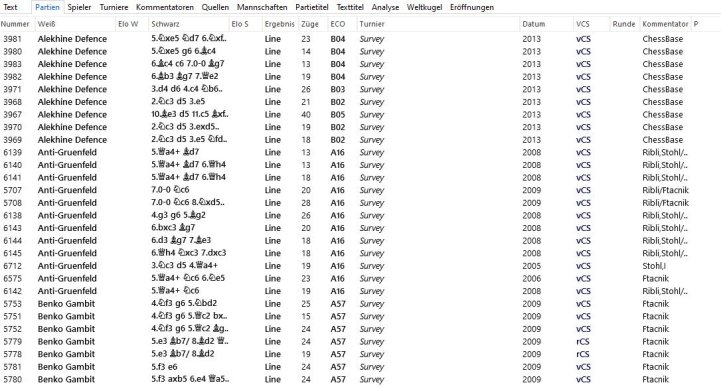At first glance, the sheer volume of openings, variants and sub-variants is impressive, to say the least. What the renowned authors, led by Thomas Stark and Dorian Rogozenco, have put together requires great attention to detail and a keen eye for the latest developments on the tournament scene.
An impressive 27 hours of video footage and countless variations and commentaries are presented in eight chapters. Some of these are aimed at professionals or seasoned amateurs wishing to update or add to their repertoire. Others are aimed at players of all levels. With the help of the ChessBase Encyclopedia of Openings, everyone can make significant progress in building their repertoire.
Dorian Rogozenco, project director and former national coach, has already given an important green light in an interview:
As complicated as the openings are, it’s not about memorizing variations, it’s about understanding them. This can be done by watching videos and tutorials, as well as actual and, ideally, annotated games.
An approach much more focused on pleasure than frustration!
Encyclopedia of Openings: the different chapters

Current aperture trends
The 2024 Opening Encyclopedia begins with an important new feature: in ten videos, some of which last between 15 and 20 minutes, Rogozenco explains the highlights of recent months from the point of view of opening theory. He reviews the major tournaments, from last year’s Tata Steel tournament in Wijk aan Zee to the January 2024 edition. All the Encyclopedia’s new features are based on this period, and Rogozenco provides an impressive overview of the results. Below the videos, you’ll find a link to the full list of opening developments since January 2023, and you can jump straight to the detailed treatment of variants by following the link that takes you to the “Ideas for your repertoire” chapter. You’ll also find links to videos dealing with other lines.

Ideas for your repertoire
As described above, you can access this chapter, which Thomas Stark describes as the “centerpiece” of the Encyclopedia, via “Current trends in opening” or via the main navigation. Here, the user has access to no fewer than 1,463 suggestions.
For greater clarity, the Encyclopedia works with drop-down menus. Firstly, openings are divided into open, semi-open, closed, semi-closed and flanking openings.
We would also like to draw your attention to the fact that the year of publication is shown above the article. This is an innovation which makes it easier for the user to know whether the article is up to date. Parts listed in the text can be opened in a new window and, in conjunction with the Mega Database, even more recent parts can be found quickly.
At the end of the article, as in CB magazine, there’s always a conclusion that allows the user to quickly understand the content of the line in question.

Videos
It’s extremely instructive to hear a GM explain how an opening works and how one variant differs in detail from another. Similar in structure to the previous chapter, and supplemented by Rainer Knaak’s explanation of the pitfalls of the opening, this chapter contains a wealth of knowledge for you to assimilate. You can also quickly get an overview of openings that have not yet been studied. The easy-to-understand English-language videos by CB magazine authors (Rogozenco, Mendonca, Sokolov, King, etc.) are also mostly from last year and have been supplemented by a few others, such as Rustam Kasimdzhanov’s analysis of a game between Caruana and Carlsen.
Tutorials
This is where things get serious: basic information on openings is an important part of the Opening Encyclopedia, even – or especially – for non-specialists. Of course, this section follows the same structure and contains, in addition to information and analysis on the opening, historical information, such as the identity of the first player to have played the opening. Did you know, for example, that the Evans Gambit is named after a ship’s captain?
At the end of each tutorial, you’ll find useful links to other ChessBase documents.

ECO list, game database, specific articles
The following chapters are intended to provide orientation in the jungle of openings. The ECO (Encyclopedia of Chess Openings) section lists not only the opening codes, but also links to the respective openings and article authors.
The game database provides an overview of the entire Encyclopedia. It comprises almost 41,000 parts.
Finally, the Opening Overview, largely maintained by Ljubomir Ftacnik, provides more than 7,500 Informator-style games – a service aimed more at more experienced players.
All in one
This section was introduced in the CB Magazine n°198. Here, a variant is analyzed in detail on the basis of an important part in terms of opening theory. The essential ideas are briefly and concisely summarized, and further examples of the parts are included.
Conclusion
As with all Encyclopedia articles, a conclusion must be drawn at the end of this article. The creators have succeeded in meticulously distilling an immense amount of knowledge into a standard work. The combination of written articles with additional links and videos is a huge advantage over print media. It’s possible to learn new openings or complete and update existing directories at unparalleled speed. Of course, this still represents a lot of work for the player, but the enjoyment factor is probably much higher than simply “cramming variants”. It will no doubt take some time to find a suitable way of working with the Encyclopedia, but this is made easier by proper handling and is also explained in several articles on the ChessBase website. The links from one topic to another and the clear structure are another great advantage.
It’s no exaggeration to speak of the Encyclopedia of Openings as a reference work. What can be used here in a very small space is truly unique – both in terms of quantity and timeliness, based among other things on the results of 24 years’ work by ChessBase, which ensures its unfailing quality.
